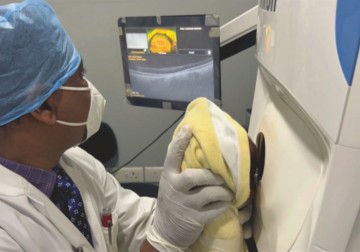In a new study from LVPEI, Drs. Akash Belenje, Rakasi U. Reddy, Subhadra Jalali, and others used optical coherence tomography to discover biomarkers that can be used to predict the recurrence risk of retinopathy of prematurity, after antibody treatment.
A premature baby begins life in adversity. The complications of their circumstance include Retinopathy of prematurity (ROP), a vision-threatening eye condition. Extreme prematurity and a lower birth weight increase the risk of ROP, where abnormal blood vessels proliferate in the retina, the innermost layer of the eye. The proliferation of these new blood vessels (neovascularization) leads to internal bleeding and scarring of the retina. Without treatment, the scars shrink and pull on the retina, detaching it, leading to blindness. Aggressive ROP (A-ROP) is a severe form of this disease, with accelerated neovascularization leading to retinal detachment.
The standard of care for ROP is laser therapy, but with an increased risk of myopia later in life. A newer treatment involves injecting antibodies into the baby’s retina that inhibit vascular endothelial growth factors (VEGFs), cellular proteins that promote the abnormal growth of blood vessels. This helps slow down retinal neovascularization while also avoiding the risk of myopia. However, anti-VEGF treatment carries the risk of ROP recurrence, ending up requiring laser therapy. Identifying biomarkers which can help predict the risk of ROP recurrence can help doctors decide which babies will need laser therapy.
Optical coherence tomography (OCT), a high-resolution, wide field retinal imaging technique, is a promising and non-invasive tool for such biomarker identification in ROP diagnosis. In a new study published in the journal Eye, Drs. Akash Belenje, Rakasi U. Reddy, Subhadra Jalali, and others from LVPEI used new generation OCT to identify biomarkers that differentiate between outcomes after anti-VEGF (Bevacizumab) treatment in babies with A-ROP. The study included 40 infants (80 eyes) with A-ROP who received Bevacizumab treatment. The infants were split into two groups: Group 1 (46 eyes) had favorable anti-VEGF outcomes, while Group 2 (34 eyes) needed laser surgery because of reactivated ROP or a lack of blood vessels in the peripheral retina after 16 weeks. OCT data for identifying biomarkers was collected before Bevacizumab injections.
Around 88% of eyes in group 2 had a hyperreflective inner retina on OCT, compared to just 26% in group 1. In group 2, 41% of the eyes showed a thinned choroid, the vascular layer above the retina, while none of the eyes in group 1 showed such thinning. Lastly, only 6% of eyes in group 2 developed cysts at the fovea, a photoreceptor-rich indentation where light focuses on the retina, indicated by low-reflective spots under OCT. In comparison, 35% of eyes in group 1 showed such cysts. So, hyperreflective retinal layers and thinned choroid are biomarkers of possible ROP recurrence. The group also found a strong association between anemia and group 2 outcome. However, the development of a cyst at the fovea indicates a good treatment outcome.
‘ROP, particularly its aggressive form needs immediate and decisive intervention. With the use of anti-VEGF injections, clinicians must decide when to use lasers or predict which babies will need additional laser therapy,’ concludes Dr. Akash Belenje, Consultant Ophthalmologist at LVPEI and the first author of the paper. ‘The introduction of new generation OCT technologies has offered newer lines of evidence to analyze additional biomarkers. This paper adds to our understanding of specific scan-based indicators that predict the need for a laser intervention for sustained effect, after controlling the aggressive phase with the anti-VEGF treatment.’
Citation
Belenje A, Reddy RU, Parmeswarappa DC, Padhi TR, Subbarao B, Jalali S. Evaluation of optical coherence tomography biomarkers to differentiate favourable and unfavourable responders to intravitreal anti-vascular endothelial growth factor treatment in retinopathy of prematurity. Eye (Lond). Published online November 15, 2023



